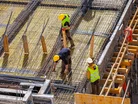Explainer: Formwork - Shaping the Future of Construction

What is formwork and why is it crucial to construction?
Formwork is a fundamental component of the construction industry, serving as the mould into which concrete is poured to create structures. As Graham Tait, Construction Manager at Laing O'Rourke, explains: "Formwork is essentially the skeleton of a building during its infancy. It provides the shape and support for concrete until it can stand on its own."
The process of formwork involves creating temporary or permanent moulds into which concrete or similar materials are poured. These moulds can be made from various materials, including timber, plywood, steel, aluminium, and more recently, engineered plastics and composites. The choice of material depends on factors such as the project's scale, complexity, and budget.
David Wilson, Senior Structural Engineer at Arup, notes: "The art of formwork lies in balancing structural integrity with cost-effectiveness and ease of use. It's a crucial element that can make or break a project's timeline and budget."
How does formwork differ across project types?
The demands of formwork vary significantly across different types of construction projects. In civil engineering and infrastructure projects, such as bridges and dams, formwork often needs to withstand immense pressure and be precisely engineered to create complex shapes.
For residential projects, the focus is often on speed and cost-efficiency. As Sarah Johnson, Project Manager at Barratt Developments, points out: "In housing developments, we're looking for formwork systems that can be quickly assembled and disassembled, allowing for rapid construction cycles."
Commercial building projects, on the other hand, may require a balance between aesthetics and functionality. "In office towers or shopping centres, we often use formwork that can create smooth, exposed concrete surfaces or intricate architectural details," says Mark Thompson, Director at Foster + Partners.
What are the main challenges in formwork?
One of the primary challenges in formwork is ensuring safety. Poorly designed or implemented formwork can lead to catastrophic failures during concrete pours. Additionally, the labour-intensive nature of traditional formwork methods can pose risks to workers.
Another significant challenge is optimising efficiency. Dr. Lisa Chen, a researcher at the University of Cambridge's Construction Engineering department, explains: "The industry is constantly seeking ways to reduce the time and labour required for formwork installation and removal. This drive for efficiency has led to innovations in modular and reusable formwork systems."
Environmental concerns also pose a challenge. The construction industry is under increasing pressure to reduce its carbon footprint, and formwork is no exception. "We're seeing a shift towards more sustainable materials and practices in formwork," says Emma Brown, Sustainability Director at Skanska UK. "This includes using recycled materials, optimising designs to reduce material waste, and exploring bio-based alternatives to traditional formwork materials."
Who are the major players in the global formwork market?
The global formwork market is dominated by several key players known for their innovative solutions and global reach. The five largest companies specialising in formwork are:
- PERI Group (Germany)
- Doka GmbH (Austria)
- ULMA Construction (Spain)
- MEVA Formwork Systems (Germany)
- NOE-Schaltechnik (Germany)
These companies have established themselves as leaders through a combination of technological innovation, global presence, and comprehensive product ranges.
How is the industry making formwork more sustainable?
Sustainability is becoming increasingly important in the formwork sector. Companies are exploring various avenues to reduce the environmental impact of their products and processes.
One approach is the development of more durable formwork systems that can be reused multiple times, reducing waste. PERI Group, for instance, has introduced its DUO system, which the company claims can be reused up to 100 times.
Another focus is on materials. "We're seeing a move towards formwork made from recycled plastics and even biodegradable materials," says Dr. Robert Taylor, Materials Scientist at Imperial College London. "These innovations not only reduce waste but also lower the carbon footprint of construction projects."
Digital technologies are also playing a role in making formwork more sustainable. Building Information Modelling (BIM) and advanced simulation software allow for more precise formwork design, reducing material waste and optimising performance.
Furthermore, some companies are exploring the use of 3D printing technology to create bespoke formwork, potentially reducing material waste and transportation costs. As John Roberts, Innovation Director at Laing O'Rourke, notes: "3D printed formwork could revolutionise the industry, allowing us to create complex shapes with minimal waste and reduced labour requirements."
The future of formwork looks set to be shaped by these sustainability initiatives, as the construction industry seeks to balance efficiency, cost-effectiveness, and environmental responsibility.
As Emma Brown of Skanska UK concludes: "The formwork of tomorrow will not only shape our buildings but also our approach to sustainable construction. It's an exciting time to be in this field, with innovations emerging that have the potential to transform the way we build."
- How Is Amazon's Mass Timber Station Aiding Sustainability?Sustainability & Green Building
- Global Coalition Targets Green Finance for Building SectorSustainability & Green Building
- Skanska and Holcim Lead Low-Carbon Road Building RevolutionSustainability & Green Building
- Why Heat Pumps Will be Vital to Net Zero TargetsSustainability & Green Building




